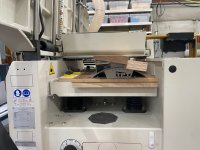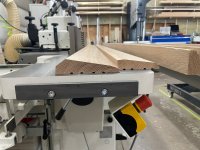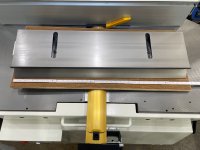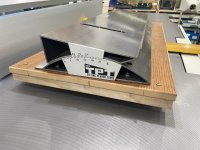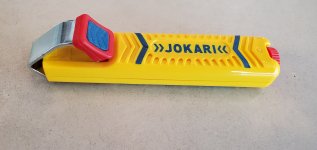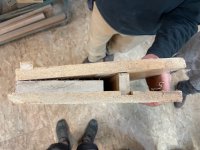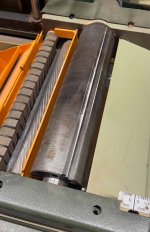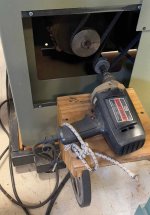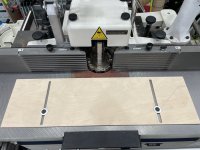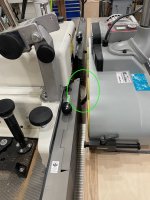Not so much a product as a technique, but I get a lot of use out of a simple "back fence" or "outboard fence" on my shaper. The "fence" itself is a piece of 6mm plywood with two slots milled to line up with a pair of tapped holes in the machine table, secured with a pair of low-profile, washer-head bolts.
[attachimg=1]
The outboard fence is really handy when processing very short pieces, for instance cabinet door rails, where the piece might so short that it wouldn't be properly supported by the in-feed and out-feed fences. The outboard fence provides for continuous support, and accommodates various widths of stock to be milled to an identical finished width.
In this case, I had milled some stop moulding at 50mm width, only to later decide I want a finished width of 42mm. For thicker stock, I would normally rip the pieces at ~44mm at the bandsaw, then run through the thickness planer at 42mm. In this case, I had already milled a profile on the edge of the stop, and didn't feel confident about having a sufficiently wide reference face to safely run through the thicknesser.
So, I used the outboard fence and the shaper as a sort of modified thickness planer. "Programming" the outboard fence is easy:
-- Shaper cutter has a major diameter of 160mm
-- Shaper fences are indexed to the centerline of the spindle
-- Desired finished dimension is 42mm
-- The face of the outboard fence should be 122mm from the spindle (80mm + 42mm= 122mm)
-- Rather than crank the fences all of the way out to 122mm, I instead use metric 1-2-3 setup blocks, utilizing the 50mm face, and set the shaper fences to 72mm (122mm - 50mm=72mm)
-- With the fences secured at 72mm, with 50mm setup blocks, I press the outboard fence against the setup blocks, and tighten the bolts.
-- To remove the setup blocks, I retract the fence plates slightly
-- Position the power feeder so the wheels are skewed towards the outboard fence
-- Perform the normal safety checks (Proper spindle speed, cutter spins freely, hood is secured, fences are secured, outboard fence is secured, power feed is secured, proper elevation, wheels are skewed towards outboard fence, etc....), then run the pieces.
[attachimg=2]
In this case, the pieces were 50mm x 18mm x 2.5m White Oak, and I much preferred to let the power feeder perform the work than hand-feeding long lumber through a saw. The setup listed above may seem like a lot, but I'd guess it probably took me all of three or four minutes to generate the setup and run the boards.
I hope it goes without saying that this technique requires the use of a power feeder, there's just no other safe way to do it. That being said, it does not necessarily require a shaper, you could perform this same operation on a router table with a power feeder, but you may need multiple passes (I removed 18mm x 8mm of material in a single pass withe the shaper).
Anyways, this outboard fence setup cost ~$10 in materials, but opens up a lot of opportunities to safely process short- or narrow- stock which might otherwise be challenging to handle. In addition to processing particularly short cabinet door pieces, I regularly use this outboard fence to "rip" materials.
I'll wrap up with the standard disclaimer that I'm not necessarily recommending the technique, and that I can't be held responsible for your setup, not responsible for injury/damage, etc....

